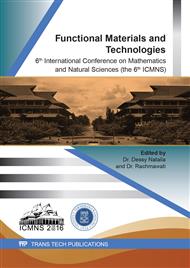[1]
M.R. Ganjali, P. Norouzi, F. Faridbod, M. Rezapour, M.R. Pourjavid, One Decade of Research on Ion Selective Electrodes in Iran (1996-2006) J. Iran Chem. Soc.4.(2007)1-29.
DOI: 10.1007/bf03245799
Google Scholar
[2]
Y.A. El-Nahdi, Lanthanum and neodymium from Egyptian monazite: Synergistic extractive separation using organophosphorous reagents, Hydrometalurgy,119 (2012) 23-29.
DOI: 10.1016/j.hydromet.2012.03.003
Google Scholar
[3]
A. Walter, P. Lusty, C. Chetmyn, A. Hill, Rare earth elements British Geological Survey, Natural Invironment Research Council, Centre of Sustainable Mineral Development, UK. (2010).
Google Scholar
[4]
M.R. Ganjali, M. Hosseini, M.P. Homedani, H.A. Zamani, Multi-walled carbon nanotube (MWCNT-NH2)/nanosilica/room temperature ion liquid (RTIL)/ ionophore nanocomposite carbon paste electrode for Nd(III),Int J.Electrochem.Sci.6 (2011) 2808-2817.
Google Scholar
[5]
P. Norouzi, M.R. Ganjali, A. Achmadalinezhad, M. Adib, Novel Neodymium(III) membrane sensor based on N-(2-Furylmethylene)pyridine-2-6-diamine, J. Braz. Chem. Soc. 17 (7) (2006).
DOI: 10.1590/s0103-50532006000700017
Google Scholar
[6]
H.A. Zamani, A. Imani, A. Arvinfar, F. Rahimi, M.R. Ganjali, F. Faridbod, S. Maghdadi, Neodymium(III)-PVC membrane sensor based on a new four dentate ionophore, Material Science and Engineering C. 37 (2010) 588- 592.
DOI: 10.1016/j.msec.2010.11.016
Google Scholar
[7]
D.S. Tyagi, S. Aishwarya, Comparative Studie of Neodymium(III) Selective Poly(vynilchloride) Electrode Based in O, N, S Donor Ionophores. Open Journal of Analytical Chemistry Research (OJACR), 1 (2013) 37-45.
DOI: 10.12966/ojacr.08.03.2013
Google Scholar
[8]
H.A. Zamani, S. Sahebnasagh, Application of 1,2-dimaleimidobenzene as a neutral ionophore in construction of a highly selective neodymium(III) liquid membrane electrode, Int. J. Electrochem. Sci. 8 (2013) 2722-2733.
Google Scholar
[9]
B. Devadas, M. Rajkumar, C. Shen-Ming, R. Saraswathi, Electrochemically Reduced Graphene Oxide/ Neodymium Hexacyanoferrate Modified Electrodes for the Electrochemical Detection of Paracetomol, Int. J. Electrochem. Sci., 7 (2012) 3339 – 3349.
Google Scholar
[10]
R. Pavithran, M. L. P. Reddy, Investigations on the Solvent Extraction And Luminescence Of Lanthanoids With Mixtures of Heterocyclic β- diketones and Various Neutral Oxo-donors, Disertasi, Chemical Sciences Division Regional Research Laboratory (CSIR) India (2005).
Google Scholar
[11]
D. Kirsanov, M. Khaydukova, L. Tachenko, A. Legin, V, Babain, Potentiometric sensor array for analysis of complex rare earths mixtures, Elctroanalysis, 24 (2012) 121-130.
DOI: 10.1002/elan.201100439
Google Scholar
[12]
I.L. Dukov, M. Atanassova, Synergistic Solvent Extraction and Separation of Lanthanides Using Mixtures of 1‐Phenyl‐3‐methyl‐4‐benzoyl‐pyrazol‐5‐one and Aliquat‐336: Influence of the Ammonium Salt Anion, Separation Science And Technology. 39 (2004) 227–239.
DOI: 10.1081/ss-120027410
Google Scholar
[13]
B.A. Uzoukwu , P.U. Adiukwu, Spectroscopic studies of Th(IV) and Pb(II) complexes of 4-trifluoroacetyl and 4-trichloroacetyl derivatives of 3-methyl-1-phenylpyrazol-5-one. J. Natn. Sci. Count. Sri Lanka, 24 (1996) 221-225.
DOI: 10.4038/jnsfsr.v24i3.5554
Google Scholar


